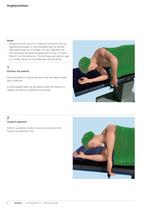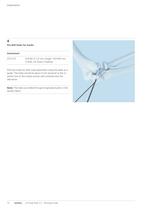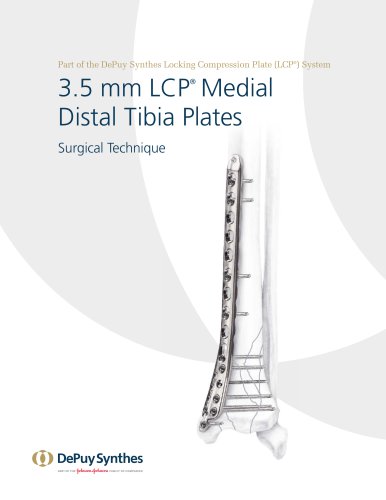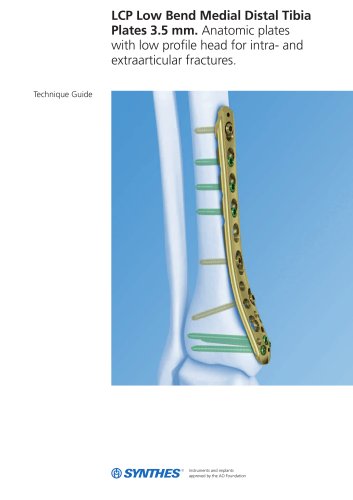 Website:
Depuy Synthes
Website:
Depuy Synthes
Group: Johnson & Johnson
Catalog excerpts

LCP Hook Plate 3.5. The simple fixation system for tension band plating. Technique Guide
Open the catalog to page 1
Table of Contents 2 4 Indications Surgical Technique LCP Hook Plate 3.5 AO Principles Introduction 5 Implantation 6 Implant Removal Implants 20 Instruments 21 Sets Product Information 18 22 Bibliography 23 Image intensier control Warning This description alone does not provide sufficient background for direct use of the instrument set. Instruction by a surgeon experienced in handling these instruments is highly recommended. Reprocessing, Care and Maintenance of Synthes Instruments For general guidelines, function control and dismantling of multi-part instruments, please refer to:...
Open the catalog to page 3
LCP Hook Plate 3.5. The simple fixation system for tension band plating. Features and Benefits Tension band plating – Elongated LCP-holes make the plate and its placement more flexible and allow for controlled compression – The spring effect facilitates reduction and a stable tension band technique – Hooks allow optimal fixation in small bone fragments and increase stability – LCP technology for increased stability in osteoporotic bone Simple and proven solution – State of the art solution for a commonly performed one third tubular plate modification* – Intuitive and easy-to-perform...
Open the catalog to page 4
Part of the modular Synthes LCP Elbow System LCP Hook Plate 3.5 – Pre-shaped hooks for fast and easy application – Small inventory, no left and right version needed Indications – Simple fractures of the olecranon (AO Types 21–B1, 21–B3, 21–C1) – Osteotomies of the olecranon for distal humerus fracture treatment – Avulsion fractures of the distal tibia and fibula LCP Olecranon Plates 3.5 – Left and right version – Choice of six lengths with 2, 4, 6, 8, 10 or 12 LCP combi-holes in the shaft – Proximal portion of the plate with 8 locking holes allows to set a maximum number of locking screws....
Open the catalog to page 5
AO Principles In 1958, the AO formulated four basic principles1, which have become the guidelines for internal fixation: Anatomic reduction The plate with its hooks, its pre-bent shape and its elongated combi-holes facilitates anatomic reduction. Stable fixation The plate hooks and the spring-effect on the dorsal cortex provide an optimal tension band mechanism. Preservation of blood supply The plate design preserves the blood supply through minimal plate to bone contact and due to a reduced number of screws. Furthermore, the plate design permits indirect reduction, thus resulting in...
Open the catalog to page 6
Indications – Simple fractures of the olecranon (AO Types 21–B1, 21–B3, 21–C1) – Osteotomies of the olecranon for distal humerus fracture treatment – Avulsion fractures of the distal tibia and fibula Synthes 5
Open the catalog to page 7
Implantation Notes – Familiarity in the use of LCP plates or instruction from an experienced surgeon is recommended (see the Synthes Technique Guide for LCP Plates, Art. No. 036.000.019). – This technique describes the application of the LCP Hook Plate 3.5 on the olecranon. The technique can also be used in a similar manner on the distal tibia and the fibula. 1 Position the patient Place the patient in lateral decubitus with the elbow flexed over a side rest. A small padded table can be placed under the forearm to support the elbow in extension if necessary. 2 Surgical approach Perform a...
Open the catalog to page 8
Prepare olecranon For fractures: Reduce the fracture 292.710 Kirschner Wire 0 1.6 mm with threaded tip, length 150/5 mm, Stainless Steel Reduce the fracture cirealy or ndireclly depending on the type of fracture, lempo'ari y fis the fragment using Kirjchner wires and/or forceps. Esamine -he redi.et on of the olecranon C n:j Í!-:-í¡¡- int,-nsitirat on. Ensire That Kirschner wires or forceps will not interfere with subsequent piale placement.
Open the catalog to page 9
Implantation 3b 1 For osteotomies Instrument 292.560 Kirschner Wire л 1.6 mm with double tip, length 150 mm, Stainless Steel Perform an incomplete osteotomy of the dorsal cortex of the olecranon using a thin oscillating saw blade to allow access to the distal humerus (1). Complete the osteotomy with a chisel in order to obtain an interdigitating fracture line. The fracture line should ideally run through the bare area of the sigmoid notch (2). 2 8 Synthes LCP Hook Plate 3.5 Technique Guide
Open the catalog to page 10
Following the osteotomy, the olecranon fragment is tipped over to the lateral side. 3 Protect the ulnar nerve on the medial side as well as the muscular branch to the anconeus on the lateral side. Perform surgery on the distal humerus as required. Insert a 1.6 mm double-tipped Kirschner wire into the proximal olecranon fragment (3). The wire is inserted from distal to proximal starting close to the articular surface and ending at the distal insertion line of the triceps. Reduce the olecranon. Check for anatomic interdigitation. Insert the Kirschner wire until it passes the cortex of the...
Open the catalog to page 11
Implantation 4 Pre-drill holes for hooks Instrument 310.210 Drill Bit л 2.0 mm, length 125/100 mm, 2-flute, for Quick Coupling Drill two holes for later hook placement using the plate as a guide. The holes should lie about 4 mm proximal to the insertion line of the triceps and be well centered over the olecranon. Note: The holes are drilled through longitudinal splits in the tendon fibers. 10 Synthes LCP Hook Plate 3.5 Technique Guide
Open the catalog to page 12
5 Place the LCP Hook Plate 3.5 Instruments 0X.113.103 LCP Hook Plate 3.5, 3 holes, length 62 mm X = 2: Stainless Steel X = 4: TAN Optional instruments 03.100.031 Bending Pliers for Reconstruction Plates 3.5 329.150 Bending Pliers for Plates 2.4 to 4.0, length 230 mm 329.040/ 329.050 Bending Irons for Plates 2.4 to 3.5, length 145 mm Place the plate on the olecranon, sinking the hooks into the appropriate pre-drilled holes. Align the plate with the axis of the proximal ulna. Consider the physiological varus bend of the proximal third of the ulna. 1 Note: If required, the plate shaft can be...
Open the catalog to page 13All Depuy Synthes catalogs and technical brochures
-
ZERO-P NATURAL™PLATE
5 Pages
-
2.0 mm LCP® Distal Ulna Plate
20 Pages
-
SYNFLATE SYSTEM
3 Pages
-
2.4 mm VA LCP™
4 Pages
-
Building on Success
16 Pages
-
HEALIX ADVANCE
4 Pages
-
RADIUS OF CURVATURE
3 Pages
-
Introducing The Variable Angle
12 Pages
-
HEALIX Anchor™ 3.4 mm
2 Pages
-
Small Battery Drive II
4 Pages
-
HEALIX ADVANCE
4 Pages
-
3.5 mm LCP™ Medial
15 Pages
-
Titanium Sternal Fixation System
34 Pages
-
MatrixRIB®FixationSystem
86 Pages
-
Mandible Trauma Solutions
2 Pages
-
Power line II
4 Pages
-
Concorde
28 Pages
-
LCP Intercarpal
31 Pages
-
LCS® COMPLETE™
2 Pages
-
Synthes TPLO.
8 Pages
-
SynFix-LR System
56 Pages
-
ATB Anterior Tension Band Plate
32 Pages
-
CONDUIT™
15 Pages
-
Brochure_FINAL
2 Pages
-
DePuy Synthes
81 Pages
-
Anspach
3 Pages
-
Orthopedic Foot Instruments
32 Pages
-
PINNACLE® Hip Solutions
12 Pages
-
Corail
24 Pages
-
S-ROM® NOILES™
68 Pages
-
TRI-LOCK® Product Rationale
12 Pages
-
Reclaim Surgical Technique
44 Pages
-
Speed
2 Pages
-
attune
80 Pages
-
HAMMERLOCK® 2
2 Pages
-
DePuy Glenoid Solutions
2 Pages
-
Trauma Solutions. Elbow
4 Pages
-
Polar
4 Pages
-
Alveolar Distractor.
4 Pages
-
Piezoelectric System
4 Pages
-
Air Power Line II
6 Pages
-
LCP Clavicle Hook Plate
4 Pages
-
TruMatch Pin Guides
16 Pages
-
P F N A
8 Pages
-
SKILL, DEDICATION,
16 Pages
-
Orthopaedics. Overview
20 Pages
-
DURALOC
16 Pages
-
Marathon Cemented Cup
20 Pages
-
REEF Surgical Technique
16 Pages
-
MatrixNEURO
8 Pages
-
Anspach XMax
4 Pages
-
Anspach eMax 2 Plus
4 Pages
-
Small Electric Drive
4 Pages
-
Air Pen Drive
4 Pages
-
Colibri II
4 Pages
-
Spine
25 Pages
-
Expert Hindfoot Arthrodesis Nail
48 Pages
-
LCP Distal Fibula Plates
32 Pages
-
TomoFix
60 Pages
-
Expert Tibial Nail PROtect
16 Pages
-
Expert Tibia Nail
84 Pages
-
Sacral Bars
16 Pages
-
Pelvic C-Clamp
20 Pages
-
Low Profile Pelvic System
16 Pages
-
Proximal Femoral (Hook) Plate
24 Pages
-
LCP
24 Pages
-
PFNA
112 Pages
-
HCS 1.5, 2.4, 3.0
36 Pages
-
LCP Wrist Fusion
32 Pages
-
LCP Compact Hand
28 Pages
-
VA-LCP Elbow
48 Pages
-
Distal Radius
44 Pages
-
Olecranon
30 Pages
-
DHP & Olecranon
4 Pages
-
LCP S-A
4 Pages
-
Epoca
4 Pages
-
Philos
32 Pages
-
MultiLoc
68 Pages












































































































